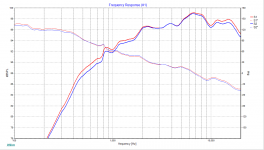Tweeter: Visaton DT94 (8 ohm)
https://www.visaton.de/sites/default/files/dd_product/DT 94.pdf
Woofer: Dayton Audio RS150P-4A (4 ohm)
https://www.daytonaudio.com/images/...rs150p-4a-reference-series-specifications.pdf
I replaced the drivers in my parents in-wall rears (blown tweeters and 4oz magnet woofers). Reason being they're going to be used as rears in a mid- fi larger home theater setup (Denon 3700 5.2.4)
I decided for the widest dispersion to use a cone with ~4.25" diameter and a 0.8" tweeter, crossed low.
The woofer is 2nd order at ~1700hz, the tweeter rolls itself off 2nd order at 1700hz. I put a cap on the tweeter for thermal protection (~1300hz)
I'm not concerned about hf distortion or cooking the tweeter - I listened for distortion and measured temperature after pink noise, and everything is fine at levels well above listening.
No, I didn't sim things, but it sounds very good. I chose things to keep everything as simple as possible (tweeter has a q of 0.54 and a flat impedance curve which is up just 10% at resonance/woofer is flat for 1.5 octaves above xover and has perfect horizontal dispersion past 80 degrees at xover)
I want to attenuate the tweeter just a little bit. My concern is: if I put 1 ohm in series with it, will q change and screw up the phase?
If yes, no big deal, the Denon 3700 has XT32 speaker/room correction and these are only rears.
I believe the increased efficiency between 9 and 16khz which ranges +1.5-4db, averaging about 2.75, is what causes the tweeter to sound bright - making want to attenuate it some. Both drivers are listed as 90db /2.83v. So maybe I should just leave it as is and EQ the tweeter?
Most importantly, will I induce ringing in the tweeter by adding series resistance while using its natural rolloff (q~0.5) as the crossover point? If so, is there a maximum amount I can add before things become audible? I assume ringing will manifest itself as a lack of clarity, which I don't want, especially around 1700hz - the ear is sensitive there and speech intelligibility would be affected (not that people talk through the rears that often, but still)
https://www.visaton.de/sites/default/files/dd_product/DT 94.pdf
Woofer: Dayton Audio RS150P-4A (4 ohm)
https://www.daytonaudio.com/images/...rs150p-4a-reference-series-specifications.pdf
I replaced the drivers in my parents in-wall rears (blown tweeters and 4oz magnet woofers). Reason being they're going to be used as rears in a mid- fi larger home theater setup (Denon 3700 5.2.4)
I decided for the widest dispersion to use a cone with ~4.25" diameter and a 0.8" tweeter, crossed low.
The woofer is 2nd order at ~1700hz, the tweeter rolls itself off 2nd order at 1700hz. I put a cap on the tweeter for thermal protection (~1300hz)
I'm not concerned about hf distortion or cooking the tweeter - I listened for distortion and measured temperature after pink noise, and everything is fine at levels well above listening.
No, I didn't sim things, but it sounds very good. I chose things to keep everything as simple as possible (tweeter has a q of 0.54 and a flat impedance curve which is up just 10% at resonance/woofer is flat for 1.5 octaves above xover and has perfect horizontal dispersion past 80 degrees at xover)
I want to attenuate the tweeter just a little bit. My concern is: if I put 1 ohm in series with it, will q change and screw up the phase?
If yes, no big deal, the Denon 3700 has XT32 speaker/room correction and these are only rears.
I believe the increased efficiency between 9 and 16khz which ranges +1.5-4db, averaging about 2.75, is what causes the tweeter to sound bright - making want to attenuate it some. Both drivers are listed as 90db /2.83v. So maybe I should just leave it as is and EQ the tweeter?
Most importantly, will I induce ringing in the tweeter by adding series resistance while using its natural rolloff (q~0.5) as the crossover point? If so, is there a maximum amount I can add before things become audible? I assume ringing will manifest itself as a lack of clarity, which I don't want, especially around 1700hz - the ear is sensitive there and speech intelligibility would be affected (not that people talk through the rears that often, but still)
Last edited:
Phase will not be an issue if you measure or simulate, usually what you change with the resistor you can modify with the filter.
When this is done without measurements you can use a parallel resistor too, as it will partially bypass the impedance peak.
When this is done without measurements you can use a parallel resistor too, as it will partially bypass the impedance peak.
Phase will not be an issue if you measure or simulate, usually what you change with the resistor you can modify with the filter.
When this is done without measurements you can use a parallel resistor too, as it will partially bypass the impedance peak.
But the filter is the tweeter's natural rolloff. The cap is there to block power from LF energy heating the voice coil, nothing more.
Edit: it's at about 1300hz now (400 below xover), if I add an ohm or two it'll be around 1100hz. I'm fine with either point, but I don't want phase affected much. Question is will it be?
Last edited:
But the filter is the tweeter's natural rolloff. The cap is there to block power from LF energy heating the voice coil, nothing more.
Edit: it's at about 1300hz now (400 below xover), if I add an ohm or two it'll be around 1100hz. I'm fine with either point, but I don't want phase affected much. Question is will it be?
Add your inline resistance between the amplifier and your existing capacitor.
This way the "Z" load seen by the cap doesn't change.
🙂
Add your inline resistance between the amplifier and your existing capacitor.
This way the "Z" load seen by the cap doesn't change.
🙂
The crossover point isn't determined by the cap though, it's just there to reduce power to the tweeter from frequencies about half an octave below xover
Last edited:
Then if an issue, try raising the XO point to roll off any audible under-damped response.
I already bought the inductors for the woofers though, which were $30 each (low resistance air core).
I know it's not common to use a tweeter's natural rolloff as the crossover point, so maybe try thinking about it like a woofer in a sealed box to be integrated with a subwoofer with a 2nd order low pass filter (in an extremely large room). If I knew more that's how I'd think of it
Last edited:
I ought to know a thing or two about the DT94... 🙂
There it is:
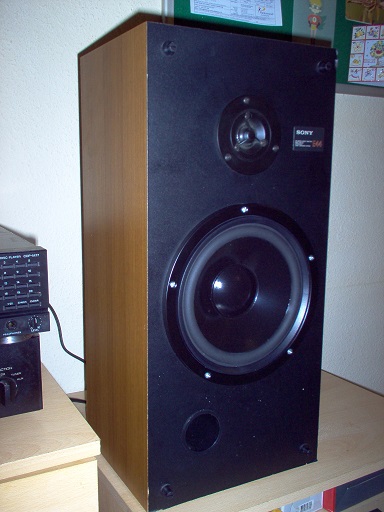
Here's one of my hare-brained (Butterworth) BW3 schemes:
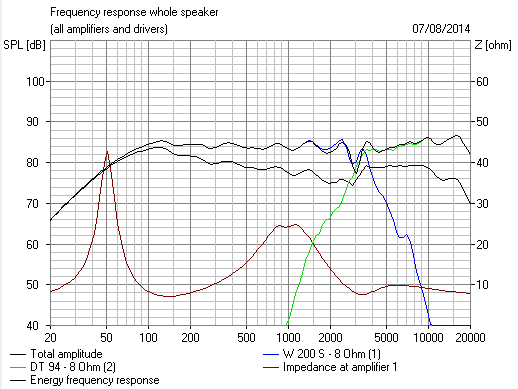
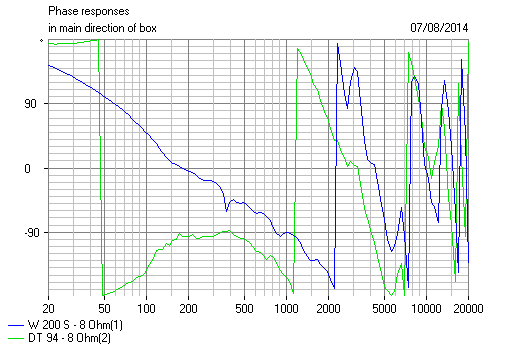
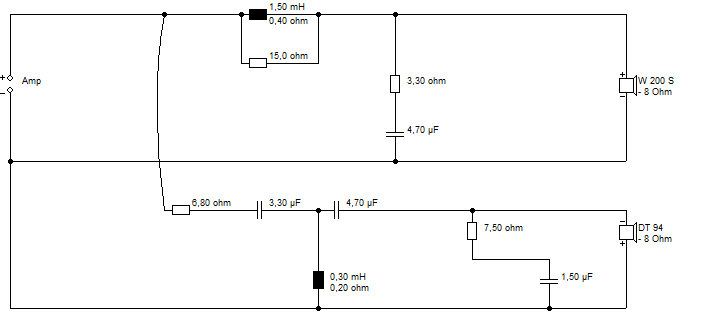
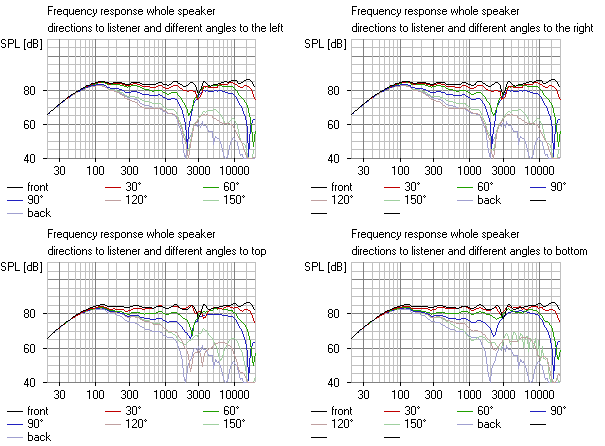
Sounded OK, IIRC. Of course, I simmed it. And so should you! 😀
I'd reckon putting the odd ohm in front of the capacitor won't break anything. Though strictly speaking the capacitor gets smaller to preserve the RC time constant. The main event is the 7.5R/1.5uF Zobel which tames the characteristic bright top end of the mylar tweeter. Single capacitor at 1700Hz seems a bit low to me, but hey, it's your baby.
There it is:
Here's one of my hare-brained (Butterworth) BW3 schemes:
Sounded OK, IIRC. Of course, I simmed it. And so should you! 😀
I'd reckon putting the odd ohm in front of the capacitor won't break anything. Though strictly speaking the capacitor gets smaller to preserve the RC time constant. The main event is the 7.5R/1.5uF Zobel which tames the characteristic bright top end of the mylar tweeter. Single capacitor at 1700Hz seems a bit low to me, but hey, it's your baby.
I ought to know a thing or two about the DT94... 🙂
There it is:
Here's one of my hare-brained (Butterworth) BW3 schemes:
Sounded OK, IIRC. Of course, I simmed it. And so should you! 😀
I'd reckon putting the odd ohm in front of the capacitor won't break anything. Though strictly speaking the capacitor gets smaller to preserve the RC time constant. The main event is the 7.5R/1.5uF Zobel which tames the characteristic bright top end of the mylar tweeter. Single capacitor at 1700Hz seems a bit low to me, but hey, it's your baby.
Nice, 3rd order butterworth. My favorite 😀
I just tamed the top end with eq and found that woofer/tweeter crossover integration is good.
Do you know about how many db the zobel brings down the peak in response at the top end?
And if so, is there a way to make it have more or less of an effect?
I was thinking of cutting off the helmholtz resonators before your suggestion
Last edited:
Human ears are insensitive to phase per se (unless there is acoustic interaction before it gets to your ears).
"Ringing" doesn't affect drivers unless resonance is inside the passband - which should never be the case with a proper tweeter. You don't hear Q.
Always wise to have a cap in the circuit to a tweeter to keep DC from amp start-up out. Even non-polarized electrolytic have negligible distortion - but even cheapest film cap better idea.
Nothing wrong with having fun doing simulations. But be prepared for surprises from your mic and ears and use screws not glue. Unless you are bi-amped, you need an L-pad to fine-tune sound.
B.
"Ringing" doesn't affect drivers unless resonance is inside the passband - which should never be the case with a proper tweeter. You don't hear Q.
Always wise to have a cap in the circuit to a tweeter to keep DC from amp start-up out. Even non-polarized electrolytic have negligible distortion - but even cheapest film cap better idea.
Nothing wrong with having fun doing simulations. But be prepared for surprises from your mic and ears and use screws not glue. Unless you are bi-amped, you need an L-pad to fine-tune sound.
B.
Last edited:
Firstly to clarify, I simply meant that you can make phase do what you want it to do.
Fact is how do you know phase is good now? It does not start out at zero and anything you do messes it up. It already comes at something related to the natural rolloff.
Fact is how do you know phase is good now? It does not start out at zero and anything you do messes it up. It already comes at something related to the natural rolloff.
All plastic tweeters are bright at the top end for some reason! The old trick was to use a heavy grille cloth to compensate... 😀
Visaton software v2.0 is now at:
Software | Visaton
Zobels effects vary slightly with the ohms you put in front of the filter. Each ohm is about 1dB level reduction. The Zobel ultimately produces about 4dB at the very top end.
To get a vague idea what is going on, you might try Lojzek's circuit with a DT94:
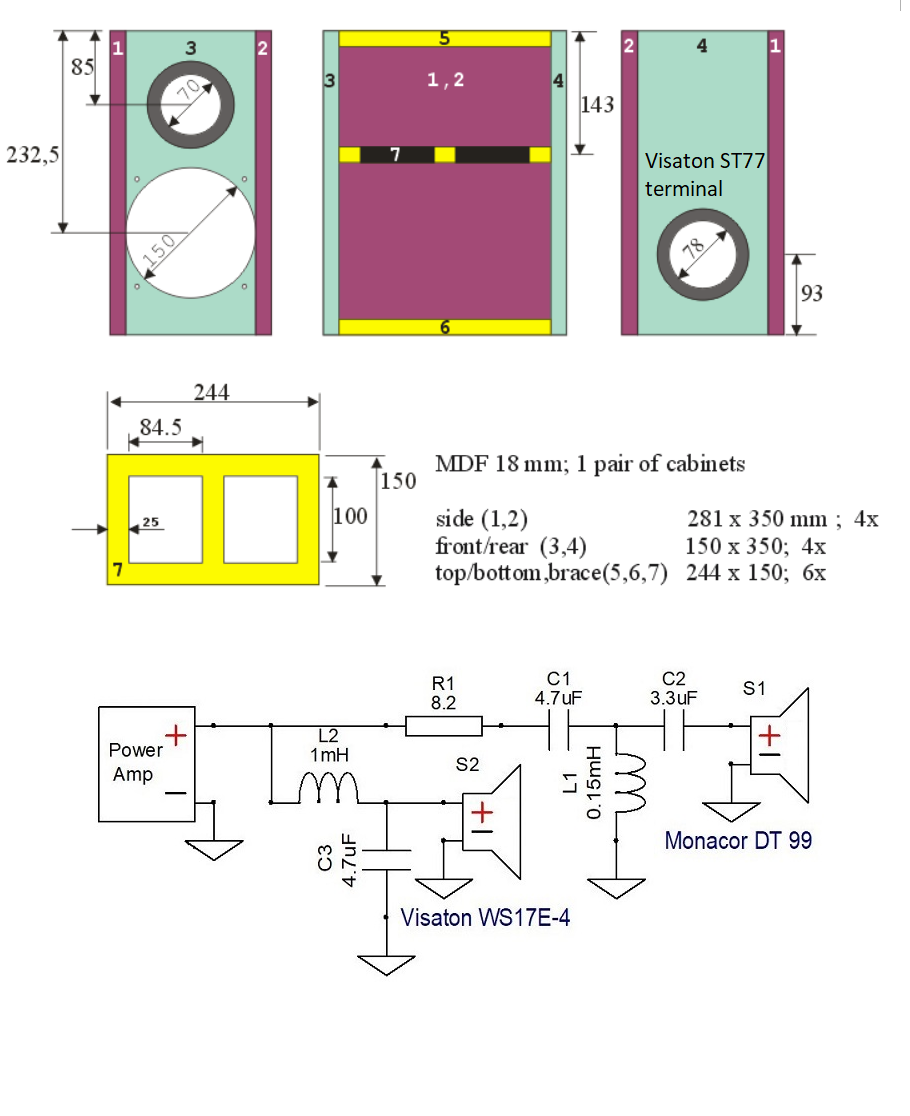
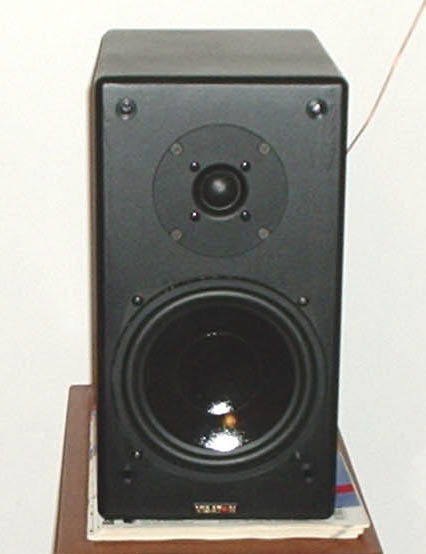
Visaton-Monacor 2 way sealed simple loudspeaker build plans
Not wildly different from what you are doing.
Visaton software v2.0 is now at:
Software | Visaton
Zobels effects vary slightly with the ohms you put in front of the filter. Each ohm is about 1dB level reduction. The Zobel ultimately produces about 4dB at the very top end.
To get a vague idea what is going on, you might try Lojzek's circuit with a DT94:
Visaton-Monacor 2 way sealed simple loudspeaker build plans
Not wildly different from what you are doing.
Human ears are insensitive to phase per se (unless there is acoustic interaction before it gets to your ears).
"Ringing" doesn't affect drivers unless resonance is inside the passband - which should never be the case with a proper tweeter. You don't hear Q.
Always wise to have a cap in the circuit to a tweeter to keep DC from amp start-up out. Even non-polarized electrolytic have negligible distortion - but even cheapest film cap better idea.
Nothing wrong with having fun doing simulations. But be prepared for surprises from your mic and ears and use screws not glue. Unless you are bi-amped, you need an L-pad to fine-tune sound.
B.
Resonance is in the passband. It's about 1900hz. Q is 0.54, basically critically damped.
I didn't mention the resonant frequency specifically in my first post, but it's easily inferred from when I said I was using the tweeter's natural 2nd order rolloff as the crossover, mentioning Q.
Edit: I know it's not usually done, but I'm doing it lol. From my understanding, I have a tweeter which is electrically optimal to work this way. Turns out, mechanically it's fine too
Last edited:
]
Isn't that a 3rd order quite a bit higher than mine, attenuated ~6db?
All plastic tweeters are bright at the top end for some reason! The old trick was to use a heavy grille cloth to compensate... 😀
Visaton software v2.0 is now at:
Software | Visaton
Zobels effects vary slightly with the ohms you put in front of the filter. Each ohm is about 1dB level reduction. The Zobel ultimately produces about 4dB at the very top end.
To get a vague idea what is going on, you might try Lojzek's circuit with a DT94:
Visaton-Monacor 2 way sealed simple loudspeaker build plans
Not wildly different from what you are doing.
Isn't that a 3rd order quite a bit higher than mine, attenuated ~6db?
Firstly to clarify, I simply meant that you can make phase do what you want it to do.
Fact is how do you know phase is good now? It does not start out at zero and anything you do messes it up. It already comes at something related to the natural rolloff.
Amplitude, slope, and frequency match, so phase is good, no?
Maybe it's not exact, but parts are 5-10% tolerance anyway, and this is at least that correct
How do I make phase do what I want using the natural rolloff of the tweeter? Only modifier I can think of is series resistance increasing q, steepening slope: changing phase. Only one direction, and only with decreased amplitude
I guess I have an answer, that an ohm or two shouldn't affect phase/q too much. It'd be nice to know how much an ohm would change q. Would it go from 0.54 to 0.6? Or to 1.0?
Last edited:
Firstly, the point is you can control it. Secondly, without seeing some plots I'd only be guessing at what you need, and whether it is good or bad.. it's unclear what you meant when you said amplitude, slope and frequency match.
However, if you can show what you have and what you want then you or we could find a way to get there.
However, if you can show what you have and what you want then you or we could find a way to get there.
Firstly, the point is you can control it. Secondly, without seeing some plots I'd only be guessing at what you need, and whether it is good or bad.. it's unclear what you meant when you said amplitude, slope and frequency match.
However, if you can show what you have and what you want then you or we could find a way to get there.
Can you control the phase of a woofer in a sealed box of fixed size? Yes, to the same extent I can control the phase of this tweeter using its natural rolloff. Which is not much and not without attenuation. I'm just wondering how much Q would change with series resistance, and at what Q ringing would become audible. All the info needed for this is on visaton's website and datasheet. I just don't know how to apply it
Edit: to clarify for you - if amplitude, slope, and crossover frequency match for two drivers (say a woofer and tweeter), then phase matches. It's very simple. Yes, it can be interperated improperly and there are other variables depending on order, but you know what I mean, don't pretend that you don't
Last edited:
Try this. I picked a random tweeter and plotted it once using nothing between the amp and driver, and once using a 1 ohm resistor.
The resonance peak is at 550Hz.
I adjusted the resistor plot (red) up by 1.5dB so you could compare the Q directly. See the top end has increased too.
The resonance peak is at 550Hz.
I adjusted the resistor plot (red) up by 1.5dB so you could compare the Q directly. See the top end has increased too.
Attachments
Try this. I picked a random tweeter and plotted it once using nothing between the amp and driver, and once using a 1 ohm resistor.
The resonance peak is at 550Hz.
I adjusted the resistor plot (red) up by 1.5dB so you could compare the Q directly. See the top end has increased too.
Thanks for the example. This tweeter has an extremely low q though, do you have any in the database with a q of ~0.5?
- Home
- Loudspeakers
- Multi-Way
- Tweeter Q change with series resistor for attenuation?
